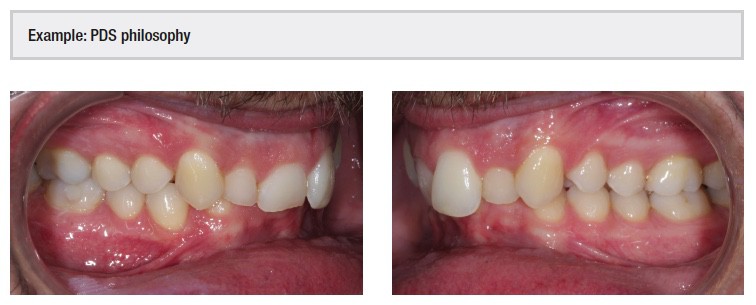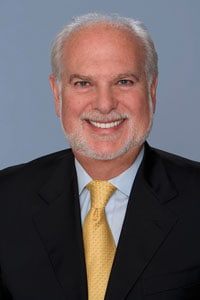Dr. Ron Roncone’s PhysioDynamicSystem (PDS) is a positive disruption to orthodontic practices. See his explanation here.
Dr. Ron Roncone discusses the PhysioDynamicSystem (PDS)
With all of the changes occurring in the orthodontic profession, especially in the past 15 years, orthodontists have had to choose how they would like to practice. Disruption — one of the newer terms — is used both in a positive and negative manner. What disruptions have and continue to occur that impact the practice of orthodontics?
We are all familiar with many negative disruptions such as DIY orthodontics. This brief article will focus on a positive disruption.
This change, however, is not new to orthodontics, but it has not yet been embraced by the majority of the profession. It is the “three-legged stool” concept of using specific wires/brackets/prescription and its impact on the number of orthodontic appointments and the length of treatment time. The wires are titanium (NiTi, HANT, SE, and Beta), and the bracket is a self-ligating interactive (SLB). The prescription is the Roncone PhysioDynamicSystem (PDS).
Heat-activated nickel-titanium (HANT) wires and superelastic (SE) NiTi wires have been used by the author since 1988. Then, as now, two .014 SE wires were used in tandem both within the SLB slot for a minimum of 6 months with no wire changes and patient visits at 10- and 12-week intervals during that time. The next titanium wire, beta titanium, is a finishing wire used again almost always in an active manner. This is different from what has become common. It is also critical to outcome! The PDS Prescription has evolved over the years from the most common pre-adjusted appliances. Philosophical descriptions of how this system works are available in courses, textbooks, etc. Over the years, studies were done in terms of 1) time required for each patient appointment and 2) total length of treatment time. In 2019, 89.6% of all patients finished full-functional treatment in seven or fewer appointments. Average treatment time in our practice is 14.1 months.
A retrospective study was done in our practice to tabulate what was routinely being accomplished. This is by no means a truly “scientific” study. However, the sheer numbers of the sample are impressive.
The following charts show not only my practice sample but also one from Dr. Anthony Patel, who was a new PDS user. He compared a sample versus one using the Damon® bracket.
PDS
Random samples over the past 10 years (June 2009 — June 2019)
- Full case starts only.
- Surgical and severe Class III non-surgical cases were removed and tabulated separately.
- Extraction and non-extraction were included in the totals (26.7% were extraction).
- Appointments included start and removal but not examinations, diagnostic records, or retention visits.
- All brackets were all metal (3%) or all ceramic (88%), or a combination of upper ceramic and lower metal (9%).
- Emergency appointments “counted” for an appointment.
- For TMD patients, splint, P.T., etc., were not counted — only the ortho-dontic portion of treatment if needed.
- Dr. Patel also followed the PDS Wire sequence which starts with tandem PDS .014 Titanol® (Forestadent®) superelastic wires in the PDS archform. Dr. Roncone recommends those wires stay active for 6 months before going into any rectangular wire. In some patients, he uses a Thermal .018 Titanol. In those cases, Dr. Roncone recommends using a transitional .020 x .020 PDS Titanol.
- The finishing wire recommend by Dr. Roncone is a .019 x .025 FMA beta-titanium wire with P-Loops.
- For the most part Dr. Patel followed this wire sequencing in the majority of his 31 PDS patients tabulated.
- However, in six of those patients a .021 x .025 NiTi was used in finishing, which is contraindicated in the PDS System. These six patients were early patient tabulated in the PDS sample.

So, what does this basic treatment look like? Twin .014 SE wires for 5½ months, which allows the following to occur:
- Alignment of teeth
- Archform
- Full molar rotation
- Correction of the Curve of Spee — (turbos are routinely used)
- 3-6 mm of dental Class II correction where necessary
- The turbos are kept in place for a minimum of 9-10 months. This allows for “bony apical fill” where posterior teeth have been extruded.
- At 5½ months, it is easy to see if brackets were precisely placed. Since twin .014’s fill the slot in the horizontal and vertical, incisal edges and marginal ridges can be checked.
- If one or more brackets need to be changed, the same twin wires can be loosened and replaced to make corrections.
After about 4 weeks, the second and final wires can be placed:
- Upper: 19 x 25 PDS Beta with “P” loops distal to the laterals for any space closure but, most importantly, to place final torque and overbite adjustments to achieve anterior guidance and esthetic “smile line.”
- Lower: 19 x 25 PDS Beta with ideal archform coordinated with the upper.



significant compensating curve. 19 x 25 PDS Beta ideal arch in lower; slight reverse curve. 4. Elastic chain UL 6-3; short
Class II elastics 6-4, 5, 3 left side. Worn for 4 months

Class II elastics can be worn if necessary (even early in treatment beginning with the second appointment at 12 weeks). Sling elastics can be worn to sock in occlusion; wires can be sectioned as necessary to combine with elastics.
Figures 1-5 show an example of the simplicity and efficiency of the PDS philosopy. Due to space limitations for this paper, only eight photos can be shown. However, the major facial asymmetry was corrected by uncoupling the anteriors and allowing the condyle on the left side to come slightly forward, accounting for one-half of the Class II molar correction. The 20/20 molar also gave full rotation of the upper left first molar. The second molar was not engaged to allow full rotation. Short Class II elastics on the left side corrected approximately 2 mm of dental Class II. The full case, including joint films, frontal, and lateral cephs, airway, pano, and placement of each tooth within cortical bone, has been shown in lectures.
Dr. Edward Lin discusses techniques that results in positive disruption to orthodontic practices in his article, “SureSmile case report: DIY aligner generalized spacing case for superior control and cost-effective treatment.” Read it here.
https://orthopracticeus.com/case-studies/suresmile-case-report-diy-aligner-generalized-spacing-case-for-superior-control-and-cost-effective-treatment
Stay Relevant With Orthodontic Practice US
Join our email list for CE courses and webinars, articles and mores



 Ronald Roncone, BA, DDS, MS, received his degrees in physiology from Marquette University and his postdoctoral Certificate in Orthodontics from Forsythe Dental Center and Harvard School of Dental Medicine. Dr. Roncone maintains a large practice in Vista, California, with 55% adult patients. Dr. Roncone has lectured extensively, presenting more than 1,000 seminars around the world, and is President and CEO of Roncone Orthodontics International®, which offers practice management courses as well as in-office consulting and marketing services.
Ronald Roncone, BA, DDS, MS, received his degrees in physiology from Marquette University and his postdoctoral Certificate in Orthodontics from Forsythe Dental Center and Harvard School of Dental Medicine. Dr. Roncone maintains a large practice in Vista, California, with 55% adult patients. Dr. Roncone has lectured extensively, presenting more than 1,000 seminars around the world, and is President and CEO of Roncone Orthodontics International®, which offers practice management courses as well as in-office consulting and marketing services.
